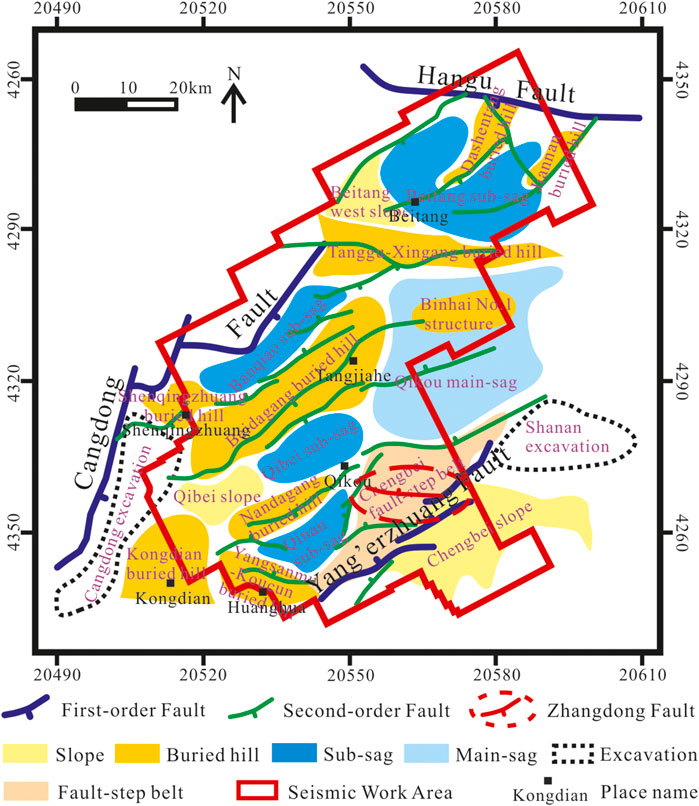- 1School of Earth Sciences, Northeast Petroleum University, Daqing, China
- 2PetroChina Dangang Oilfield Company, Tianjin, China
In order to study the distribution law of oil and gas above and below the regional mudstone caprocks damaged by fault in petroliferous basins, based on the study of the sealing mechanism and degree of regional mudstone caprocks damaged by fault during the hydrocarbon accumulation period, the paleo-juxtaposition thickness of regional mudstone caprock was calculated by determining the paleo-fault throw of faults and the paleo-thickness of regional mudstone caprocks during the hydrocarbon accumulation period. According to the relation between the paleo-juxtaposition thickness of regional mudstone caprocks at known well points in the study area and the distribution of oil and gas above and below the regional mudstone caprock, the maximum juxtaposition thickness required for the upper and lower connection of the fault-associated fracture zone in the regional mudstone caprock was determined. On this basis, a set of prediction methods for the sealing capacity of regional mudstone caprocks damaged by fault during the hydrocarbon accumulation period was established. Then, this method was applied to the prediction of the damage degree distribution of the Zhangdong Fault to the regional mudstone caprock of the middle sub-member of the first member of the Shahejie Formation in the middle and late depositional periods of the Minghuazhen Formations in Qikou Sag of the Bohai Bay Basin during the hydrocarbon accumulation period. The results show that the damage degree of the Zhangdong Fault to the regional mudstone caprock of the middle sub-member of the first member of the Shahejie Formation during the hydrocarbon accumulation period is large. The largest damage appears in the east, with an a-value greater than 1, followed by the west, with an a-value between 0.5 and 1. The relatively minor damage occurs in the middle west part, with an a-value less than 0.5. The middle part is conducive to the accumulation and preservation of oil and gas generated from the source rock of the underlying third member of the Shahejie Formation, which is consistent with the fact that oil and gas discovered in the lower sub-member of the first member of the Shahejie Formation near the Zhangdong Fault are mainly distributed in its middle part. It shows that this method is feasible to predict the damage degree distribution of regional mudstone caprocks during the hydrocarbon accumulation period.
Introduction
With the deepening of oil and gas exploration, it has been found that oil and gas are distributed above and below the regional mudstone caprocks damaged by fault, and some parts have more oil and gas than others (Gong et al., 2019; Fu et al., 2021; Zhu et al., 2021). In addition to the influence of the development of fault-associated traps and sand bodies (Zeng et al., 2021; Song et al., 2022; Zeng et al., 2022), it is mainly affected by the sealing degree distribution of regional mudstone caprocks damaged by fault during the hydrocarbon accumulation period. The greater the sealing capacity degree of regional mudstone caprock damaged by fault, the less the oil and gas under it; on the contrary, the more the oil and gas under it (Zeng et al., 2010; Zeng et al., 2013; Gong et al., 2021a; Gong et al., 2021b). This shows that accurately determining the sealing capacity degree distribution of regional mudstone caprocks damaged by fault during the hydrocarbon accumulation period is crucial for correctly understanding the distribution law of oil and gas above and below regional mudstone caprocks damaged by fault and guiding oil and gas exploration.
Some studies have been conducted on the sealing degree of regional mudstone caprocks damaged by fault, which can be summarized into the following three aspects: first, according to the relative size of fault throw and regional mudstone caprock thickness, the damage degree of fault to the distribution continuity of regional mudstone caprock has been studied (Lyu et al., 2008; Fu and Yang, 2013; Sun et al., 2013; Jiang et al., 2021). It is concluded that the larger the fault throw and the smaller the thickness of regional mudstone caprock, the greater the damage degree of fault to regional mudstone caprock; otherwise, the smaller the damage degree of fault to regional mudstone caprock (Fu et al., 2014a; Lyu et al., 2014; Fu et al., 2016). Second, based on the relative size of displacement pressure of fault rock and regional mudstone caprock, research is carried out regarding the damage degree of fault to the sealing capacity of regional mudstone caprock (Wang et al., 2017; Yu et al., 2019). It is considered that the smaller the displacement pressure of fault rock and the greater the displacement pressure of regional mudstone caprock, the greater the damage degree of fault to the sealing capacity of regional mudstone caprock; otherwise, the damage degree is smaller (Fu et al., 2014b; Fu et al., 2014c; Fu et al., 2015; Fu and Li, 2017; Zhan and Fu, 2018). Third, by combining the damage degree of fault to the distribution continuity of regional mudstone caprock and the damage degree of fault to the sealing capacity of regional mudstone caprock, the comprehensive damage degree of fault to the sealing capacity of regional mudstone caprock is investigated (Hou et al., 2015; Wang et al., 2017; Zhan et al., 2017; Jiang, 2019). It is believed that the greater the damage degree of fault to the distribution continuity and sealing capacity of regional mudstone caprock, the greater the comprehensive damage degree of fault to the sealing capacity of regional mudstone caprock; otherwise, the comprehensive damage degree of fault is smaller.
However, these studies mainly focus on the damage degree of fault to the sealing capacity of regional mudstone caprock after the fault activity stops. There are relatively few studies on the sealing degree of regional mudstone caprocks damaged by fault during the fault activity period. It is considered that as long as the fault grows in sections in the regional mudstone caprock, which are connected up and down to become the oil and gas migration and transport channels, the oil and gas can migrate upward through the regional mudstone caprock along the fault, and the sealing capacity of the regional mudstone caprock is completely damaged by the fault (Wang et al., 2014; Fu et al., 2015; Fu and Wang, 2018; Hu et al., 2018). The damage degree of fault to the sealing capacity of regional mudstone caprock is not studied according to the relative size of the paleo-juxtaposition thickness of regional mudstone caprock, which is undoubtedly not conducive to the correct understanding of the distribution of oil and gas above and below the regional mudstone caprock. For this purpose, the research on the prediction method of the sealing degree distribution of regional mudstone caprock damaged by fault is of great significance for correctly understanding the distribution law of oil and gas above and below the regional mudstone caprock damaged by fault and guiding its oil and gas exploration.
Geological Setting
The Zhangdong Fault in Qikou Sag of the Bohai Bay Basin was selected in this article. The aforementioned method was applied to predict the sealing degree distribution of regional mudstone caprock damaged by this fault in the middle sub-member of the first member of the Shahejie Formation (E3s1M) during the hydrocarbon accumulation period, and the feasibility of this method for predicting the sealing degree distribution of regional mudstone caprock damaged by the fault during the hydrocarbon accumulation period was verified by analyzing the relationship between the prediction result and the existing hydrocarbon distribution in the lower sub-member of the first member of the Shahejie Formation (E3s1L) near the Zhangdong Fault.
Located in the south of Qikou Sag, the Zhangdong Fault is a normal fault that strikes nearly east–west and extends for about 21.6 km in plane, as shown in Figure 1. The fault inclines to the north with a dip angle of 30–70° and breaks from the base upward to the near surface. It is a long-term inherited fault, as shown in Figure 2. At present, drilling near the Zhangdong Fault has revealed the Paleogene Kongdian (E2k), Shahejie (E3s), and Dongying formations (E3d), Neogene Guantao (N1g) and Minghuazhen formations (N2m), and a small amount of quaternary strata (Q). The oil and gas discovered near the Zhangdong Fault are mainly distributed in the Shahejie Formation and are mostly enriched in E3s1L. The caprock is the regional mudstone caprock of E3s1L. The oil and gas mainly come from the source rock of the underlying third member of the Shahejie Formation (E3s3), which belongs to the lower source rock, upper reservoir-type combination of source rock, reservoir, and caprock. The Zhangdong Fault connects the source rock of the underlying E3s3 and the overlying E3s1L and is active in the middle and late depositional periods of N2m, so it should be the oil source fault of E3s1L. Figure 2 shows that oil and gas discovered in E3s1L near the Zhangdong Fault are mainly distributed in its middle part, which is mainly affected by the damage degree of the Zhangdong Fault to the regional mudstone caprock in E3s1M during the hydrocarbon accumulation period, in addition to the influence of trap structure and sand body development. Therefore, an accurate prediction of the damage degree distribution of the Zhangdong Fault to the regional mudstone caprock of E3s1M during the hydrocarbon accumulation period should be the key for correctly understanding the oil and gas distribution law of E3s1L near the Zhangdong Fault.
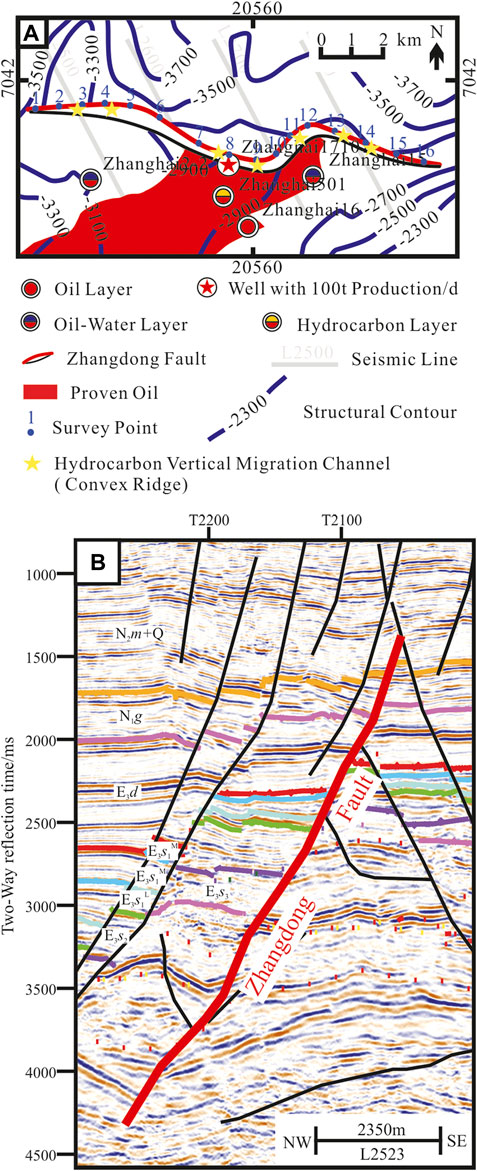
FIGURE 2. Relation diagram of the Zhangdong Fault development and oil and gas distribution in E3s1L. (A) Plan; (B) Profile.
Methods
Sealing Mechanism and Degree Distribution Characteristics of Regional Mudstone Caprocks Damaged by Fault During the Hydrocarbon Accumulation Period
A large number of oil and gas exploration practices show that the faults that can damage the regional mudstone caprock are usually relatively large in scale, and these faults are often the transport channels for oil and gas migration (Zhou et al., 2007; Sun et al., 2012; Fu et al., 2014a). During the hydrocarbon accumulation period, these active faults grow in sections in the regional mudstone caprock, which are connected up and down to become the upward migration channels of oil and gas through the regional mudstone caprock, and the oil and gas under the regional mudstone caprock migrate upward along the fault, so that the sealing capacity of the regional mudstone caprock is damaged by fault, as shown in Figure 3. In fact, the process of segmented growth and connection of faults in the regional mudstone caprock is a process of connecting the upper and lower fault-associated fracture zones in the regional mudstone caprock. If the damage degree of the fault to the sealing ability of regional mudstone caprock is different and the connection degree of upper and lower fault-associated fracture zones in the regional mudstone caprock is different, the connectivity of oil and gas transport channels is different, the upward migration characteristics of oil and gas through the regional mudstone caprock along the fault are different, and the sealing degree of the regional mudstone caprock damaged by the fault is also different. The greater the sealing degree of the regional mudstone caprock damaged by fault, the better the distribution continuity of the connecting zone formed by fault-associated fractures in the regional mudstone caprock and the easier it is for oil and gas under the regional mudstone caprock to migrate upward through the regional mudstone caprock along the fault-associated fracture zone, as shown in Figure 4A; on the contrary, the smaller the sealing degree of the regional mudstone caprock damaged by fault, the poorer the distribution continuity of the connecting zone formed by fault-associated fractures in the regional mudstone caprock and the harder it is for oil and gas under the regional mudstone caprock to migrate upward through the regional mudstone caprock along the fault-associated fracture zone, as shown in Figure 4B.
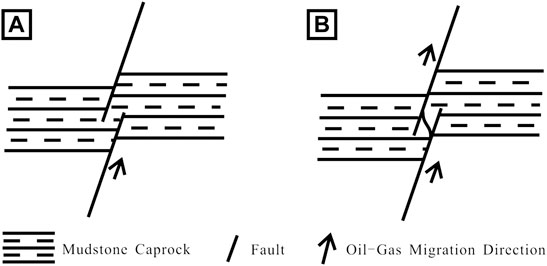
FIGURE 3. Diagram of regional mudstone caprock damaged by fault during the hydrocarbon accumulation period. (A) Mudstone caprock not damaged by fault; (B) mudstone caprock damaged by fault.
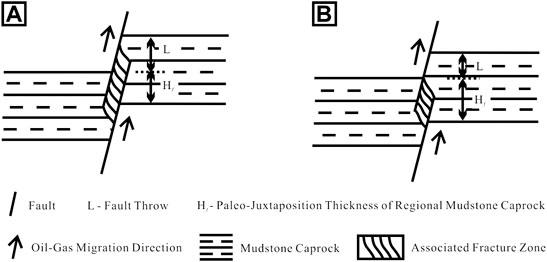
FIGURE 4. Diagram of the sealing degree of regional mudstone caprock damaged by fault during the hydrocarbon accumulation period. (A) Mudstone caprock is largely damaged by fault (L > Hf); (B) mudstone caprock is slightly damaged by fault (L < Hf).
Figure 4 shows that the sealing degree (a) of regional mudstone caprocks damaged by fault during the hydrocarbon accumulation period can be expressed by Eq. 1 as follows:
where
For the two cases in Figures 4A,B, the calculation method of Hf is consistent.
It can be obtained from Eq. 1 that the a-value is directly proportional to the maximum juxtaposition thickness required to connect the fracture zone up and down in the regional mudstone caprock and is inversely proportional to the paleo-juxtaposition thickness of the regional mudstone caprock. The higher the a-value, the greater the damage degree of the fault to the sealing of regional mudstone caprock; otherwise, it is smaller.
This a-value calculation method is only applicable to normal faults. The sealing mechanism of a reverse fault is different from that of a normal fault and is more complex, which is not suitable for calculating an a-value by this method.
Prediction Method of Sealing Degree Distribution of Regional Mudstone Caprock Damaged by Fault During the Hydrocarbon Accumulation Period
In order to predict the sealing degree distribution of the regional mudstone caprocks damaged by fault during the hydrocarbon accumulation period, it is necessary to determine the paleo-juxtaposition thickness of regional mudstone caprocks at different parts of fault during the hydrocarbon accumulation period and the maximum juxtaposition thickness required for the upper and lower connection of fault-associated fracture zones in regional mudstone caprock. The sealing degree distribution of regional mudstone caprocks damaged by fault at different parts during the hydrocarbon accumulation period can be calculated according to Eq. 1.
The fault throughgoing horizon in regional mudstone caprock was counted with 3D seismic data, and the faults that are active in the hydrocarbon accumulation period and connect the underlying source rock and regional mudstone caprock were regarded as the faults that damage the regional mudstone caprock. The current thickness of the regional mudstone caprocks broken by the damage faults was counted, and the paleo-thickness during the hydrocarbon accumulation period was restored by the method of stratigraphic paleo-thickness restoration (Tan et al., 2005; Huang et al., 2006; Jiang et al., 2012; Sun et al., 2017), as shown in Figure 5A. The method of stratigraphic paleo-thickness restoration refers to the functional relationship that the porosity of clastic rock strata decreases exponentially with the increase of depth according to the principle of constant strata skeleton under normal compaction. On this basis, the paleo-buried depth and paleo-thickness of each stratum in different geological periods can be obtained by strata stripping. Three-dimensional seismic data were applied to count the present fault throw of the damage faults in the regional mudstone caprock, and the paleo-fault throw during the hydrocarbon accumulation period was restored by the maximum fault throw subtraction method (Liu et al., 2012; Wang et al., 2018), as shown in Figure 5B. The maximum fault throw subtraction method uses the maximum offset of any point in the fault plane in a set of strata to subtract the maximum fault throw developed in the upper strata and can obtain the paleo fault throw of the fault plane in the sedimentary period. The paleo-juxtaposition thickness of the regional mudstone caprock was calculated by subtracting the paleo-fault throw of the damage fault from the paleo-thickness of the regional mudstone caprock, as shown in Figure 5C.
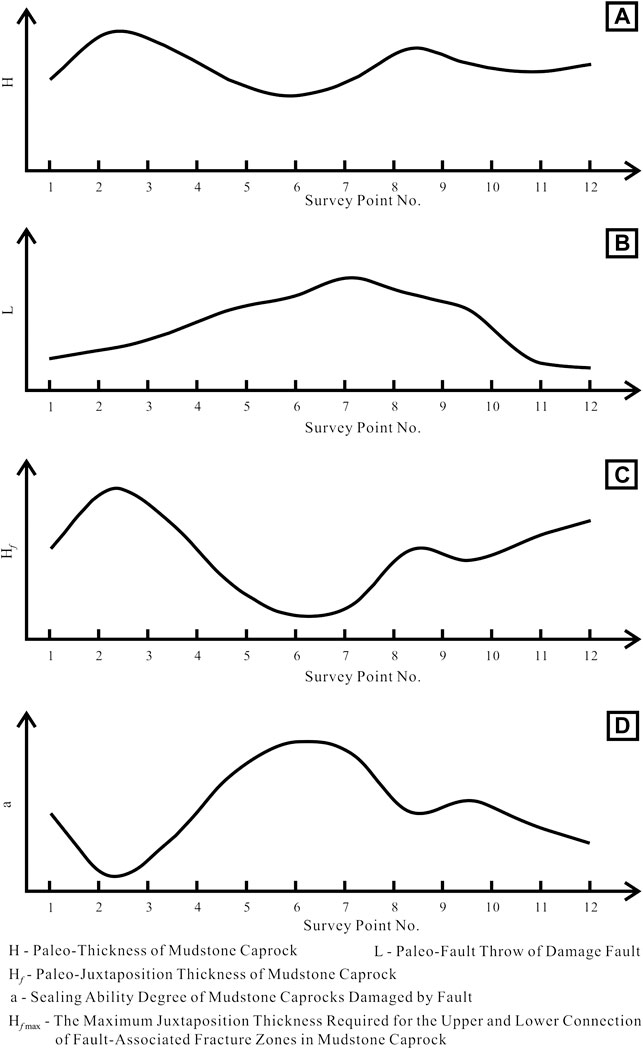
FIGURE 5. Diagram of the determination of sealing degree distribution of regional mudstone caprocks damaged by fault during the hydrocarbon accumulation period. (A) Paleo-thickness of regional mudstone caprock; (B) Paleo-fault throw of damage fault; (C) Paleo-juxtaposition thickness of regional mudstone caprock; (D) Sealing ability degree of regional mudstone caprocks damaged by fault.
Due to the limitations of current research methods and the quality of seismic data, the maximum juxtaposition thickness required for the upper and lower connection of fault-associated fracture zones in the regional mudstone caprock cannot be directly determined. It can only be determined indirectly by applying the drilling data to count the paleo-juxtaposition thickness of the regional mudstone caprock at known well points in the study area and the oil and gas display characteristics above and below it and taking the minimum paleo-juxtaposition thickness of the regional mudstone caprock where oil and gas are only distributed below the regional mudstone caprock as the maximum juxtaposition thickness required for the upper and lower connection of fault-associated fracture zones in the regional mudstone caprocks, as shown in Figure 6. If the paleo-juxtaposition thickness of regional mudstone caprock is greater than the maximum juxtaposition thickness required for the upper and lower connection of fault-associated fracture zones in regional mudstone caprock, oil and gas cannot migrate vertically through mudstone caprock and can only distribute below the regional mudstone caprock. On the contrary, if the paleo-juxtaposition thickness of regional mudstone caprock is less than the maximum juxtaposition thickness required for the upper and lower connection of fault-associated fracture zones in regional mudstone caprock, oil and gas will pass through the regional mudstone caprock, which can gather and distribute both below and above the regional mudstone caprock.
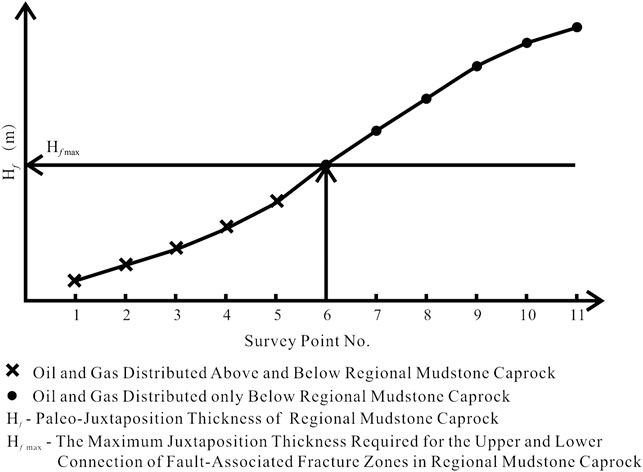
FIGURE 6. Diagram of the determination of the maximum juxtaposition thickness required for the upper and lower connection of the fault-associated fracture zone in regional mudstone caprock.
By substituting the paleo-juxtaposition thickness of the regional mudstone caprock at different parts of the fault and the maximum juxtaposition thickness required for the upper and lower connection of the fault-associated fracture zone in regional mudstone caprock identified previously into Eq. 1, the sealing degree of the regional mudstone caprock damaged by the fault at different parts can be calculated, as shown in Figure 5D.
Results and Discussion
According to the drilling and seismic data, the fault throw of the Zhangdong Fault in the regional mudstone caprock of E3s1M and the thickness of E3s1M regional caprock faulted by the Zhangdong Fault were counted. The paleo-fault throw of the Zhangdong Fault and the paleo-thickness of regional mudstone caprock of E3s1M in the middle and late depositional period of N2m during the hydrocarbon accumulation period were restored by the maximum fault throw subtraction method (Liu et al., 2012; Wang et al., 2018) and stratigraphic paleo-thickness restoration method (Tan et al., 2005; Huang et al., 2006; Jiang et al., 2012; Sun et al., 2017). By subtracting the former from the latter, the paleo-juxtaposition thickness of the regional mudstone caprock in E3s1M was calculated, as shown in Figure 7. It can be seen from Figure 7 that the paleo-juxtaposition thickness of the regional mudstone caprock of E3s1M in the Zhangdong Fault is relatively large in the middle west parts, the paleo-juxtaposition thickness of E3s1M in the east and west is relatively small, the local paleo-juxtaposition thickness in the east and west is less than zero, and the minimum paleo-juxtaposition thickness can reach more than -165 m in the east.
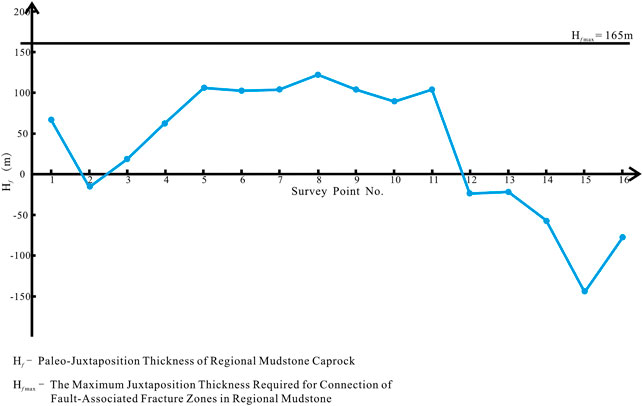
FIGURE 7. Paleo-juxtaposition thickness distribution of the regional mudstone caprock of E3s1M in the Zhangdong Fault during the hydrocarbon accumulation period.
The relationship between the paleo-juxtaposition thickness of the regional mudstone caprock in E3s1Mof Qikou Sag in the middle and late depositional periods of N2m during the hydrocarbon accumulation period and its upper and lower oil and gas distribution was counted with drilling data, as shown in Figure 8. The minimum paleo-juxtaposition thickness when oil and gas are only distributed under the regional mudstone caprock of E3s1M was taken as about 165 m, which is the maximum juxtaposition thickness required for the upper and lower connection of fault-associated fracture zones in the regional mudstone caprock of E3s1M.
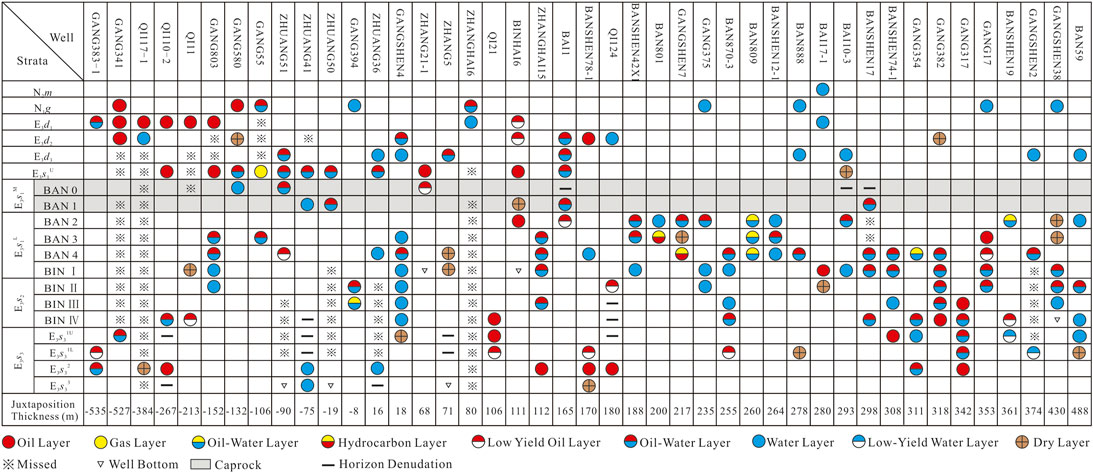
FIGURE 8. Diagram of the determination of the maximum juxtaposition thickness required for upper and lower connection of fault-associated fracture zones in regional mudstone caprock of E3s1M in Qikou Sag.
By substituting the paleo-juxtaposition thickness of E3s1M at different parts of the Zhangdong Fault and the maximum juxtaposition thickness required for the upper and lower connection of fault-associated fracture zones in the regional mudstone caprock of E3s1M into Eq. 1, the damage degree distribution of the regional mudstone caprock of E3s1M at different parts of the Zhangdong Fault can be calculated, as shown in Figure 9. Figure 9 indicates that the regional mudstone caprock of E3s1M was completely damaged by the Zhangdong Fault in the middle and late depositional periods of the Minghuazhen Formation during the hydrocarbon accumulation period, but different parts exhibited different damage degrees. The Zhangdong Fault in the east has the greatest damage to the regional mudstone caprock of E3s1M, with an a-value greater than 1, followed by the west end, where the damage degree a-value of the Zhangdong Fault to the regional mudstone caprock of E3s1M is more than 0.5, and the maximum is more than 1. The Zhangdong Fault in the middle has the least damage to the regional mudstone caprock of E3s1M, with an a-value less than 0.5.
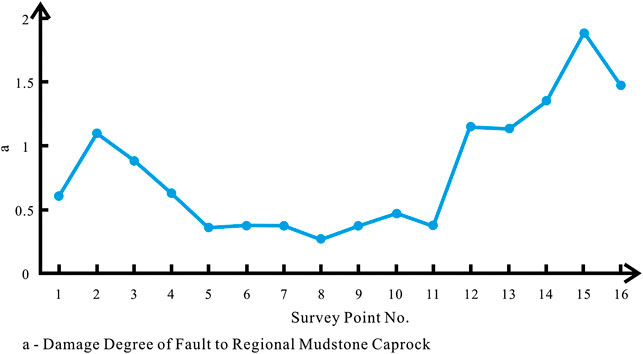
FIGURE 9. Damage degree of the Zhangdong Fault to the regional mudstone caprock of E3s1M during the hydrocarbon accumulation period.
According to Figure 2A, oil and gas discovered in E3s1L near the Zhangdong Fault are mainly distributed in its middle part, which is just the distribution part where the regional mudstone caprock of E3s1M was slightly damaged by the Zhangdong Fault during the hydrocarbon accumulation period (as shown in Figure 9). Because only in this part, the oil and gas generated and discharged from the source rock of underlying E3s3 migrate to E3s1L along the Zhangdong Fault and then migrate upward through the regional mudstone caprock of E3s1M, with relatively less lost oil and gas, which is conducive to the accumulation and preservation of oil and gas in E3s1L, and thus oil and gas can be found by drilling; otherwise, no oil and gas will be found.
Conclusion
1) The degree of sealing ability of regional mudstone caprock damaged by fault during the hydrocarbon accumulation period is primarily affected by the relative size of the paleo-juxtaposition thickness of regional mudstone caprock and the maximum juxtaposition thickness required for the upper and lower connection of fault-associated fracture zones in regional mudstone caprock. The smaller the paleo-juxtaposition thickness of regional mudstone caprock, the greater the maximum juxtaposition thickness required for the upper and lower connection of fault-associated fracture zones in regional mudstone caprock and the larger the sealing capacity degree of regional mudstone caprock damaged by fault; otherwise, it is smaller.
2) The paleo-juxtaposition thickness of regional mudstone caprock was calculated by determining the paleo-fault throw of faults and the paleo-thickness of regional mudstone caprocks during the hydrocarbon accumulation period. Based on the relationship between the paleo-juxtaposition thickness of regional mudstone caprocks at known well points in the study area and the distribution of oil and gas above and below the regional mudstone caprock, the maximum juxtaposition thickness required for the upper and lower connection of fault-associated fracture zones in the regional mudstone caprock was determined. On this basis, a set of prediction methods for the sealing capacity of regional mudstone caprocks damaged by fault during the hydrocarbon accumulation period was established. The practical application proves that this method is feasible to predict the sealing ability distribution of regional mudstone caprocks damaged by fault during the hydrocarbon accumulation period.
3) The damage degree of the Zhangdong Fault to the regional mudstone caprock of E3s1M in the middle and late depositional periods of N2m in Qikou Sag of the Bohai Bay Basin during the hydrocarbon accumulation period is large; the largest damage appears in the east, with an a-value greater than 1, followed by the west, with an a-value between 0.5 and 1; the least damage occurs to the middle part, with an a-value less than 0.5. The middle part is conducive to the accumulation and preservation of oil and gas generated from the source rock of E3s3 in E3s1L, which is consistent with the fact that oil and gas discovered in E3s1L near the Zhangdong Fault are mainly distributed in its middle part.
4) This method mainly applies to the prediction of the sealing ability degree of regional mudstone caprocks damaged by normal faults in sand-mudstone petroliferous basins during the hydrocarbon accumulation period.
Data Availability Statement
The original contributions presented in the study are included in the article/Supplementary Material; further inquiries can be directed to the corresponding author.
Author Contributions
XH contributed to the idea and writing of this manuscript. GF contributed to supervision and funding acquisition. ML contributed to writing-review and editing. FJ, GH and WJ contributed to review and writing of the revised manuscript. All authors contributed to manuscript revision and approved it for publication.
Funding
This research was supported by the Joint Funds of National Natural Science Foundation of China (Grant No.41872157, No.42072157, No.41872153 and No.42102165).
Conflict of Interest
Authors FJ, GH, and WJ were employed by the company PetroChina Dagang Oilfield Company.
The remaining authors declare that the research was conducted in the absence of any commercial or financial relationships that could be construed as a potential conflict of interest.
Publisher’s Note
All claims expressed in this article are solely those of the authors and do not necessarily represent those of their affiliated organizations, or those of the publisher, the editors, and the reviewers. Any product that may be evaluated in this article, or claim that may be made by its manufacturer, is not guaranteed or endorsed by the publisher.
References
Fu, G., Li, N., and Hu, M. (2014a). Gas Sealing Limited of Faulted Thickness of Caprock and its Controlling Effect on Gas Distribution: an Example from Xujiaweizi Depression of Songliao Basin. Nat. Gas. Geo. 25 (7), 971–979. (in Chinese with English abstract). doi:10.11764/j.issn.1672-1926.2014.07.0971
Fu, G., and Li, S. (2017). Restoration Method of Closed Evolution History of Fractured Mudstone Cap Rock and its Application. Earth Sci. 42 (09), 1590–1598. (in Chinese with English abstract). doi:10.3799/dqkx.2017.514
Fu, G., Wang, B., and Shi, J. (2014b). Comprehensive Quantitative Evaluation Method of Sealing Oil-Gas Ability of Caprock and its Application. J. Zhejiang Univ. Eng. Sci. 48 (01), 174–180. (in Chinese with English abstract). doi:10.3785/j.issn.1008-973X.2014.01.027
Fu, G., Wang, H., and Hu, X. (2015). Prediction Method and Application of Caprock Faulted-Contact Thickness Lower Limit for Oil-Gas Sealing in Fault Zone. J. China Univ. Pet. Nat. Sci. 39 (03), 30–37. (in Chinese with English abstract). doi:10.3969/j.issn.1673-5005.2015.03.004
Fu, G., and Wang, H. (2018). Prediction of Favorable Oil-Gas Transportation Parts of Oil-Source Faults on Seismic Data. Oil Geophys. Prospect. 53 (01), 161–168+910. (in Chinese with English abstract). doi:10.13810/j.cnki.issn.1000-7210.2018.01.020
Fu, G., Wu, W., and Li, N. (2014c). Control Effect of Three Large Faults on the Gas Pools in the Xujiaweizi Faulted Depression, Songliao Basin. Nat. Gas. Ind. 34 (07), 7–12. (in Chinese with English abstract). doi:10.3787/j.issn.1000-0976.2014.07.002
Fu, G., and Yang, J. (2013). Sealing of Matching between Fault and Caprock to Oil-Gas Migration along Faults: an Example from Middle and Shallow Strata in Nanpu Depression. Earth Sci. 38 (4), 783–791. (in Chinese with English abstract). doi:10.3799/dqkx.2013.076
Fu, G., Zhang, B., and Wu, W. (2016). Mechanism and Detection of Regional Mudstone Caprock Sealing Oil and Gas Migration along Transporting Fault. J. China Univ. Pet. Nat. Sci. 40 (03), 36–43. (in Chinese with English abstract). doi:10.3969/j.issn.1673-5005.2016.03.005
Fu, X., Song, X., Wang, H., Liu, H., Wang, S., and Meng, L. (2021). Comprehensive Evaluation on Hydrocarbon-Bearing Availability of Fault Traps in a Rift Basin: A Case Study of the Qikou Sag in the Bohai Bay Basin, China. Petroleum Explor. Dev. 48 (4), 787–797. doi:10.1016/s1876-3804(21)60066-6
Fu, X., Sun, B., Wang, H., and Meng, L. (2015). Faults Segmentation Growth Quantitative Characterization and its Application on Sag Hydrocarbon Accumulation Research. J. China Univ. Min. Techn. 44 (02), 271–281. (in Chinese with English abstract). doi:10.13247/j.cnki.jcumt.000170
Gong, L., Fu, X., Wang, Z., Gao, S., Jabbari, H., Yue, W., et al. (2019). A New Approach for Characterization and Prediction of Natural Fracture Occurrence in Tight Oil Sandstones with Intense Anisotropy. Bulletin 103 (6), 1383–1400. doi:10.1306/12131818054
Gong, L., Gao, S., Liu, B., Yang, J., Fu, X., Xiao, F., et al. (2021b). Quantitative Prediction of Natural Fractures in Shale Oil Reservoirs. Geofluids 2021, 1–15. doi:10.1155/2021/5571855
Gong, L., Wang, J., Gao, S., Fu, X., Liu, B., Miao, F., et al. (2021a). Characterization, Controlling Factors and Evolution of Fracture Effectiveness in Shale Oil Reservoirs. J. Petroleum Sci. Eng. 203, 108655. doi:10.1016/j.petrol.2021.108655
Hou, J., Wang, W., and Jiao, J. (2015). A Comprehensive Quantitative Research Method of Destroy Degree of Faults to Mudstone Caprock and its Application. Geol. Rev. 61 (04), 961–967. (in Chinese with English abstract). doi:10.16509/j.georeview.2015.04.022
Hu, C., Fu, G., and Zhan, M. (2018). Hydrocarbon Upward Uigration Condition in Different Directions and Prediction Method of Distribution Area. Geol. Rev. 64 (01), 227–236. (in Chinese with English abstract). doi:10.16509/j.georeview.2018.01.017
Huang, H., Luo, Q., Wang, C., Jiang, X., and Zhu, Z. (2006). Mesozoic Group Denudation Recover and its Petroleum Geologic Significations in the West Qaidam Basin. Pet. Explor. Dev. 33 (1), 44–48. (in Chinese with English abstract). doi:10.3321/j.issn:1000-0747.2006.01.010
Jiang, S., Zhou, H., and Song, C. (2012). The Method Based on Structural Evolution for Recovering Erosion Thickness. Appl. Mech. Mater. 130-134, 2261–2265. doi:10.4028/www.scientific.net/amm.130-134.2261
Jiang, Y., Zhao, K., and Hu, H. (2021). A Quantitative Method for Evaluating Fault Vertical Opening and Sealing Properties during Hydrocarbon‐Charging Periods. Acta Geol. Sin. ‐ Engl. Ed. 95 (4), 1420–1422. doi:10.1111/1755-6724.14787
Jiang, Z. (2019). Comprehensive Evaluation of Fault Vertical Sealing Ability with Mudstone Caprocks. Oil Geophys. Prospect. 54 (03), 650–655+489. (in Chinese with English abstract). doi:10.13810/j.cnki.issn.1000-7210.2019.03.019
Liu, Z., Lyu, Y., Sun, Y., Li, Y., and Zhang, D. (2012). Characteristics and Significance of Syngenetic Fault Segmentation in Hydrocarbon Accumulation: an Example of Yuanyanggou Fault in Western Sag, Liaohe Depression. J. China Univ. Min. Techn. 41 (5), 793–799. (in Chinese with English abstract). CNKI:SUN:ZGKD.0.2012-05-017
Lyu, Y., Wan, J., Sha, Z., Fu, X., and Fu, G. (2008). Evaluation Method of Sealing Capability of Fractured Caprock and its Application. Chin. J. Geol. 41 (01), 162–174. (in Chinese with English abstract). doi:10.3321/j.issn:0563-5020.2008.01.011
Lyu, Y., Xu, C., Fu, G., Liu, N., Cui, S., and Pang, L. (2014). Oil-Controlling Models of Caprock-Fault Combination and Prediction of Favorable Horizons for Hydrocarbon Accumulation in Middle Shallow Sequences of Nanpu Sag. Nat. Gas. Geo. 35 (01), 86–97. (in Chinese with English abstract). doi:10.11743/ogg20140111
Song, X., Wang, H., Fu, X., Meng, L., Sun, Y., Liu, Z., et al. (2022). Hydrocarbon Retention and Leakage in Traps Bounded by Active Faults: a Case Study from Traps along the NDG Fault in the Qinan Area, Bohai Bay Basin, China. J. Petroleum Sci. Eng. 208, 109344. doi:10.1016/j.petrol.2021.109344
Sun, P., Guo, Z., He, W., and Liu, W. (2017). Restoration of Eroded Thickness of the Neogene Strata in the Western Qaidam Basin and its Significance for Oil and Gas Occurrence. Acta Geol. Sin. - Engl. Ed. 91 (4), 1352–1362. doi:10.1111/1755-6724.13366
Sun, T., Fu, G., Lyu, Y., and Zhao, R. (2012). A Discussion on Fault Conduit Fluid Mechanism and Fault Conduit Form. Geol. Rev. 58 (06), 1081–1090. (in Chinese with English abstract). doi:10.3969/j.issn.0371-5736.2012.06.008
Sun, Y., Zhao, B., Dong, Y., Zheng, X., and Hu, M. (2013). Controls of Faults on Hydrocarbon Migration and Accumulation in the Nanpu Sag. Oil Gas. Geol. 34 (04), 540–549. (in Chinese with English abstract). doi:10.11743/ogg20130417
Tan, K., Wei, P., Lyu, X., and Mu, Z. (2005). Research on Quantitative Resumption Method of Stratum Paleothickness and its Application: Aking Ludong Area in Zhunge’er Basin as an Example. Natur. Gas Ind. 25, 24–26. doi:10.3321/j.issn:1000-0976.2005.10.008 (in Chinese with English Abstract)
Wang, H., Fu, X., Fu, G., Lyu, Y., Du, W., and Liu, T. (2014). Vertical Segmentation Growth of Fault and Oil Source Fault Determination in Fuyang Oil Layer of Sanzhao Depression. Earth Sci. 39 (11), 1639–1646. (in Chinese with English abstract). doi:10.3799/dqkx.2014.146
Wang, H., Fu, X., Liu, S., Chu, R., Liu, B., and Shi, P. (2018). Quantitative Discrimination of Normal Fault Segment Growth and its Geological Significance: Example from the Tanan Depression, Tamtsag Basin, Mongolia. Aust. J. Earth Sci. 65 (5), 711–725. doi:10.1080/08120099.2018.1462850
Wang, W., Fu, G., and Hu, M. (2017). Method for Predicting Oil and Gas Sealing Area of Mudstone Caprock in Fracture Development Zone by Seismic Data. Prog. Geophys. 32 (03), 1251–1257. (in Chinese with English abstract). CNKI:SUN:DQWJ.0.2017-03-040. doi:10.6038/pg20170340
Yu, Y., Deng, R., and Yuan, H. (2019). Prediction Method and its Application of Migration Zones of Oil and Gas Migration to Multiple Caprock by Oil Source Faults. Prog. Geophys. 34 (01), 244–250. (in Chinese with English abstract). CNKI:SUN:DQWJ.0.2019-01-033
Zeng, J., Wang, C., Guo, S., Yu, Y., Zhang, Z., Yang, H., et al. (2021). Petroleum Migration Characteristics in the Northeastern Part of the Baiyun Depression, Pearl River Mouth Basin, South China Sea. Acta Geol. Sin. ‐ Engl. Ed. 95 (1), 208–231. doi:10.1111/1755-6724.14623
Zeng, L., Gong, L., Guan, C., Zhang, B., Wang, Q., Zeng, Q., et al. (2022). Natural Fractures and Their Contribution to Tight Gas Conglomerate Reservoirs: a Case Study in the Northwestern Sichuan Basin, China. J. Petroleum Sci. Eng. 210, 110028. doi:10.1016/j.petrol.2021.11002sS810.1016/j.petrol.2021.110028
Zeng, L., Su, H., Tang, X., Peng, Y., and Gong, L. (2013). Fractured Tight Sandstone Oil and Gas Reservoirs: a New Play Type in the Dongpu Depression, Bohai Bay Basin, China. Bulletin 97 (3), 363–377. doi:10.1306/09121212057
Zeng, L., Wang, H., Gong, L., and Liu, B. (2010). Impacts of the Tectonic Stress Field on Natural Gas Migration and Accumulation: a Case Study of the Kuqa Depression in the Tarim Basin, China. Mar. Petroleum Geol. 27 (7), 1616–1627. doi:10.1016/j.marpetgeo.2010.04.010
Zhan, M., and Fu, G. (2018). Effective Sealed Part Prediction in the Fault-Caprock Configuration on Seismic Data. Oil Geophys. Prospect. 53 (04), 842–848+657. (in Chinese with English abstract)CNKI:SUN:SYDQ.0.2018-04-023
Zhan, M., Fu, G., Qiu, C., and Yang, Z. (2017). A New Predicting Method for Comprehensive Damage Degree of Mudstone Caprock by Fault and its Application. J. Jilin Univ. (Earth Sci. 47 (06), 1687–1694. (in Chinese with English abstract). doi:10.13278/j.cnki.jjuese.201706108
Zhou, G., Peng, S., Zhang, X., Wang, Y., and Yang, Y. (2007). Contrast of Transporting Characteristics between Faults and Sandbodies of Medium and Large Gas Fields in China. Pet. Explor. Dev. 34 (06), 653–657. doi:10.3321/j.issn:1000-0747.2007.06.003
Keywords: hydrocarbon accumulation period, fault, sealing of regional mudstone caprock, prediction method, damage degree
Citation: Han X, Fu G, Liang M, Jin F, Han G and Jiang W (2022) Prediction Method of Sealing Capacity Distribution of Regional Mudstone Caprocks Damaged by Fault During the Hydrocarbon Accumulation Period. Front. Earth Sci. 10:908627. doi: 10.3389/feart.2022.908627
Received: 30 March 2022; Accepted: 05 May 2022;
Published: 17 June 2022.
Edited by:
Wei Ju, China University of Mining and Technology, ChinaReviewed by:
Youlu Jiang, China University of Petroleum, Huadong, ChinaZhenxue Jiang, China University of Petroleum, Beijing, China
Copyright © 2022 Han, Fu, Liang, Jin, Han and Jiang. This is an open-access article distributed under the terms of the Creative Commons Attribution License (CC BY). The use, distribution or reproduction in other forums is permitted, provided the original author(s) and the copyright owner(s) are credited and that the original publication in this journal is cited, in accordance with accepted academic practice. No use, distribution or reproduction is permitted which does not comply with these terms.
*Correspondence: Guang Fu, ZnVndWFuZzIwMDhAMTI2LmNvbQ==
 Xu Han
Xu Han Guang Fu1*
Guang Fu1* Mugui Liang
Mugui Liang